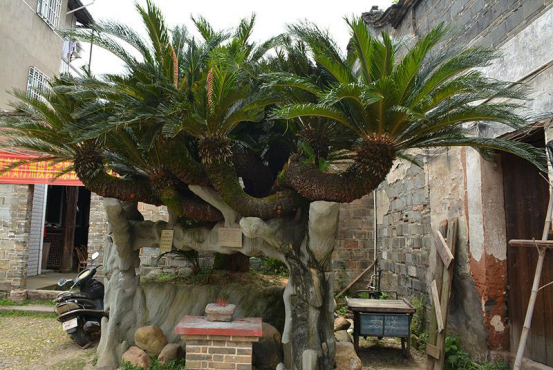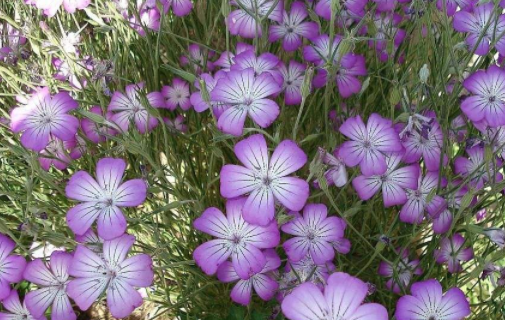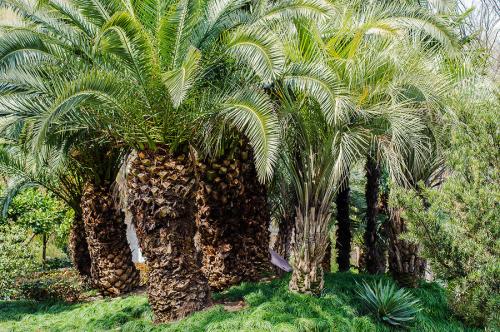The planting of iron tree
1. Soil selection
Iron trees like the environment where the soil is fertile, loose and well drained, so do not use clayey soil when planting. It is recommended to use rotten leaf soil or sandy loam, culture soil and other soil.
2. Temperature requirement
Tieshu likes the hot environment, but at the same time it requires ventilation. So when planting in the north, it can be moved outdoors in early April and indoors in November. For the indoor temperature should be maintained at about 10 degrees Celsius, the lowest not less than 0 degrees Celsius.
3. Lighting requirements
Iron trees that like high temperatures also like sunny and warm places, but they can't be exposed to the sun in summer. It can be planted in places with plenty of light all the year round.

Did you find it easy to plant iron trees? Often hear the iron tree blossom, do not know what the iron tree blossoms like! You might as well start planting iron trees now!
The planting method of iron tree introduces the function of iron tree.
Nowadays, iron trees can be seen in the courtyards of many families, so how to raise iron trees is more suitable for growth. Let's have a look together.
Iron tree, also known as cycad, Phoenix tail tree, fire-avoiding banana, evergreen, native to the tropics, is one of the most primitive seed plants in existence, known as "living fossils", and is also an endangered plant under key protection in the world. The iron tree grows slowly, it can produce a new leaf from the top of the stem every year, and it is not easy to see the blossom, so there is the saying that "the iron tree blossoms for thousands of years".
Iron tree evergreen woody, cylindrical culm, with significant traces of fallen leaves, the whole plant is umbrella-shaped, leaves clump with stem ends, for large pinnate compound leaves, up to 2-3 meters long, composed of dozens or more pairs of slender leaflets; the leaflets are linear, rolled in at birth, straightened and stiff, dark green and shiny after growth. Flowers terminal, dioecious, male cones Terete, yellow; female cones capitate-oblate, densely brown tomentose. Seeds Obovate, slightly flattened, brownish red. The flowering period is from June to July, and the seeds mature in October.
Other plants of the same genus are South China Cycas, also known as Cycas prickly, with pinnate leaves 1.2-1.5 m long, 80-120 pairs of leaflets, with short thorns on both sides of the leaf axis; dark orange seeds at maturity, producing Guangdong, Guangxi, Fujian and other provinces and regions; Sichuan cycads, which are very similar to cycads, with large, leathery and slightly curved pinnate leaves, produced in Emeishan, Leshan, Sichuan and Nanping, Fujian.
The culture method of iron tree
1. Soil: potted iron tree is suitable for slightly acidic sandy soil with good drainage, loose and fertile soil.
2. Temperature: the iron tree likes to be warm, so it should be cooled by spraying water properly when it is hot in summer, and the room temperature should be kept at about 10 ℃ in winter. As the growth of the iron tree is relatively slow, the hot sun should be avoided in summer, otherwise it is easy to cause the phenomenon of scorched leaves and yellow leaves. The iron tree has strong cold resistance, but when the winter temperature is 0 ℃, it should move indoors or in a warm place to survive the winter.
3. Light: the iron tree can not be placed indoors for too long, because the iron tree likes the light, and the lack of light will make its new leaves sparse, thin and green. Therefore, the four seasons of iron tree breeding need to be placed in a sunny place, especially when new leaves grow in spring and autumn, they should be maintained in direct sunlight, and then move indoors to watch when the new leaves grow old.
4. Watering: iron tree is more resistant to drought, likes to dry and avoid dampness, and can generally be rewatered after the soil is dry. if it is watered too much, it is easy to rot roots and bad leaves. It is usually watered about 10 days in winter, 3-5 days in spring and autumn, and once in the morning and evening in summer. Watering should see dry and wet, iron tree basin soil long-term accumulation of water is too wet, will cause yellow leaves, rotten roots.
5. Fertilization: in the growing season of iron tree, topdressing should be applied frequently, mainly nitrogen and potassium fertilizer, and rotten cake fertilizer and water is the best. Fertilization should pay attention to the frequent application of thin fertilizer, do not be too thick. In order to promote the dark green and glossy leaves, an appropriate amount of ferrous sulfate solution can be added to the fertilizer. Fertilizing should pay attention to more vanadium fertilizer and water, or you can put some rust iron into the soil, or buy iron tree special fertilizer in the flower market, which can make the iron tree leaves dark green and glossy and improve the ornamental value.
6. Pruning: iron trees send out new leaves once or twice a year. In order to have a beautiful posture, the old leaves and withered yellow leaves of the next year should be cut off, and the leaves that are too dense or too long should also be trimmed according to the situation to keep the tree shape symmetrical.
The function of iron tree
The function of iron tree: 1. Ornamental
Cycad tree shape is quaint, the trunk is stout, hard as iron; the feather leaves are smooth and bright, evergreen all the year round, it is a precious ornamental tree species, with high ornamental value.
The function of iron tree: 2, decorate the home
Iron trees are mostly planted in the front steps and lawns in the south, while large potted plants are arranged in the courtyard, corridors and halls. The iron trees are beautifully shaped, which are used to decorate the home to give people a sense of closeness to nature and a sense of comfort.
The function of iron tree: 3. Purify the air
Iron tree is also good for air purification and improvement, with the effect of absorbing toxic and harmful gases such as sulfur dioxide, nitrogen peroxide, benzene, fluorine, mercury vapor, lead vapor and so on.
The function of iron tree: 4. Medicinal use
The roots, flowers and seeds of the iron tree can be used as medicine, and the leaves can be used to stop bleeding, detoxify and relieve pain, for all kinds of bleeding, gastritis, gastric ulcer, hypertension, neuralgia, amenorrhea, cancer; flowers can regulate qi and relieve pain, tonify the kidney and consolidate essence, for stomachache, spermatorrhea, leucorrhea, dysmenorrhea; seeds can calm the liver, lower blood pressure, and be used for hypertension. Root can dispel wind and activate collaterals, tonify the kidney, for tuberculosis hemoptysis, kidney deficiency toothache, low back pain, leucorrhea, rheumatism joint numbness pain, fall injury.
The function of iron tree: 5. Edible
Cycad trunk pith contains starch, edible, some ethnic minorities in Xishuangbanna pick its tender leaves as vegetables; it can also be used as a raw material for wine-making, which can improve the rate of alcohol production.
The above is the relevant introduction of this article, I believe you have a simple understanding of this after reading it, if necessary, you can continue to pay attention to the No. 1 home network to learn more information.
Propagation methods and planting points of Iron Tree
Iron tree, also known as cycad, is a kind of ornamental plant. What are the ways of reproduction of iron tree, and what are the main points of planting iron tree? Next, the editor has sorted out the information about Irontree for you, hoping to be helpful to you.
Sowing and reproduction
It is carried out from May to June, because the seeds are large and the skin is thick, so it is suitable to sow in the indoor pot. The depth of soil cover is 2 cm ~ 3 cm, and it can germinate in 2 weeks under the high temperature of 30C~33 C.
Large cycads can sprout and absorb buds in the stem disk below the soil layer, and can grow 3 to 4 buds at a time, such as sufficient fertilizer and water, grow well, grow more than 10 buds at a time, break them from the mother and plant them to form a new plant.
Buried stem propagation
It is to make use of the stem of the old cycad pile dug in the mountain forest, cut into thick slices of 10 cm ~ 15 cm with a sharp knife, shallowly buried in moist plain sand soil, maintained under sparse shade, and always maintain a water content of about 60%. Half a year later, the old stem can sprout and suck around the stem segment, and the old stem gradually shrinks. After that, the sucking buds were separated and transferred to the culture soil for planting.
Key points of Iron Tree planting
Under normal circumstances, the iron tree can produce two or three rounds of new leaves every spring. If it is found that the plant does not sprout new buds or leaves yellowing for two or three years, it should timely check whether the root system is rotten, take timely measures, control moisture, cover it up in advance to make it sprout new leaves, and rejuvenate and continue to grow after a period of time.
The above is the information I introduced to you about the iron tree. For more information, please continue to follow the succulent flower bed. We will provide you with more information.
- Prev

Matters needing attention in breeding of Mai Xianweng
When you put on the pot, you need to put some broken tiles at the bottom of the flowerpot to facilitate drainage, then put a layer of rotten fertilizer, and finally put it into the soil. Today's content is over. I hope this article can help friends who want to raise wheat fairy Weng, so that they can raise more and better wheat fairy Weng.
- Next

Planting method of jujube tree
The main results are as follows: 1, the growth of jujube trees needs a certain space and more nutrients, so it should be planted in places where the land is more fertile. If multiple plants are planted, a certain distance should be reserved for them to grow. 2, before planting treatment to dig a good drainage ditch, ditch width of 10-20 cm. And dig up the soil.
Related
- Fuxing push coffee new agricultural production and marketing class: lack of small-scale processing plants
- Jujube rice field leisure farm deep ploughing Yilan for five years to create a space for organic food and play
- Nongyu Farm-A trial of organic papaya for brave women with advanced technology
- Four points for attention in the prevention and control of diseases and insect pests of edible fungi
- How to add nutrient solution to Edible Fungi
- Is there any good way to control edible fungus mites?
- Open Inoculation Technology of Edible Fungi
- Is there any clever way to use fertilizer for edible fungus in winter?
- What agents are used to kill the pathogens of edible fungi in the mushroom shed?
- Rapid drying of Edible Fungi

